Monmouth, Monmouthshire
Up to 1834
In 1743, the Monmouth Overseers purchased several houses in Back Lane (now St John’s Street) 'for the building of a Workhouse for the Benefit of this Parish'. Overmonnow, the part of Monmouth to the west of the river Monnow, had one even earlier, immediately to the south of St Thomas's Church. In 1761, a workhouse for all the town’s poor was established on Weirhead Street, where Monmouth School for Boys now stands. In 1776, the rented premises could house forty inmates, who were occupied in spinning.
Eden, in his 1797 State of the Poor, records of Monmouth that:
In 1835, the Monmouth town workhouse was on Weir Head Street with Joseph Harper as its Governor.
When Assistant Poor Law Commissioner George Clive visited the area in 1836, prior to the formation of the Monmouth union, he uncovered a multitude of malpractices and poor conditions.
In Coleford poorhouse I found an idiot, who had been there 48 years; during all this time, winter and summer, this poor wretch had had no other covering than a canvass shirt, no shoes even or stockings. At night he was, as the master expressed it, " ticed" or forced into an out-house, a place unfit even for an animal; a hole in the wall was the only window; there he slept in some damp straw on the bare ground, for there was not even a stone floor. The answer to my remonstrances was, "He does not feel cold;" an assertion which the appearance of the shivering wretch sufficiently disproved. Yet in this very place did I receive remonstrances from some well-meaning, but more interested persons, against the cruelty of removing the poor to a well-conducted establishment at Monmouth.
[Note that prior to 1894, Coleford was a 'tithing' within the parish of Newland.]
After 1834
Monmouth Poor Law Union was formed on 11th July 1836. Its operation was overseen by an elected Board of Guardians, 37 in number, representing its 31 constituent parishes as listed below (figures in brackets indicate numbers of Guardians if more than one):
County of Monmouth:
Cwmcarvan, Dingestow, Dixton Newton, Llandenny, Llandogo, Llangattock-Vibon-Avel, Llangoven, Llanishen, Llantillio Crossenny, Llanvihangel-ystern-Llewern, Mitchel Troy, Monmouth (4), Penalt, Penrose, Pen-y-Clawdd, Ragland, Rockfield, St. Maughan's, Skenfreth, Tregare, Trelleck, Wonaston.
County of Gloucester:
English Bicknor, Newland (4), Staunton.
County of Hereford:
Ganarew, Garway, Llanrothal, Welsh Bicknor, Welsh Newton, Whitchurch.
Later Addition: West Dean (in 1843), Park Grace-Dieu (1867).
The population falling within the Union at the 1831 census had been 19,618 with parishes ranging in size from Pen-y-Clawdd (population 46) to Monmouth itself (4,916). The average annual poor-rate expenditure for the period 1833-35 had been £7,188 or 7s.4d. per head of the population.
The Monmouth Union took over the existing Monmouth parish workhouse which was located on Weirhead Street at the south side of the town centre. In 1837, the Poor Law Commissioners approved the expenditure of £800 on its alteration and enlargement.
In 1870, a new Union workhouse was erected at the north of the town at the west side of the Old Hereford Road. The buildings cost around £6,000 and could accommodate around 200 inmates. The architect was G.C. Haddon.
A contemporary Post Office directory recorded:
The location and layout of the site are shown on the 1901 map below.
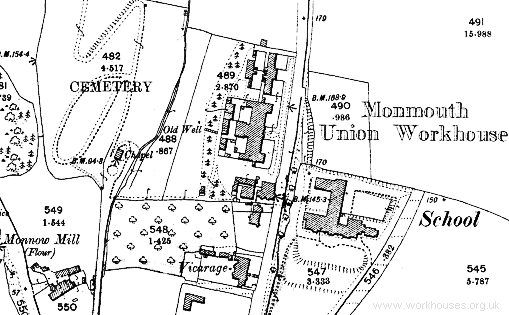
Monmouth workhouse site, 1901.
The large T-shaped main block was mostly two storeys high. Administrative offices and the master and matron's quarters lay at the centre, with the dining hall at the rear. Males and female inmates were placed at each side with the infirm being separated from the able-bodied. The area to the rear of the building divided up into airing yards for each class. At the west of the site were a line of buildings containing workrooms, the washhouse and laundry .
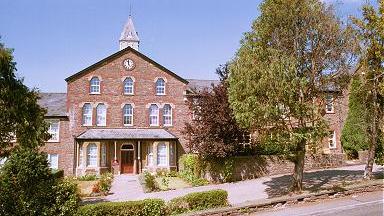
Monmouth main block from the east, 2000.
© Peter Higginbotham.
The entrance lodge and board-room block lay at the south of the site, with a receiving block for new arrivals at its rear.
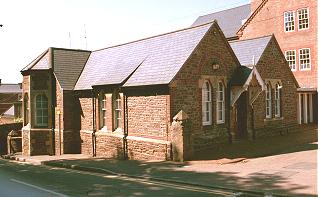
Monmouth lodge and board-room, 2000.
© Peter Higginbotham.
The chapel was located at the centre rear of the main block.
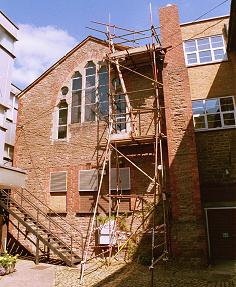
Monmouth chapel, 2000.
© Peter Higginbotham.
The infirmary was located in a separate block at the north of the main workhouse. A small block containing nurses' accommodation and isolation wards stood at the rear.
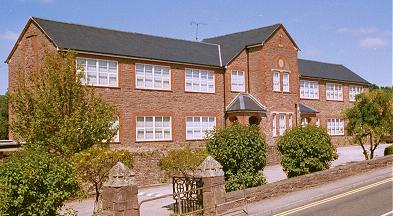
Monmouth, 2000.
© Peter Higginbotham.
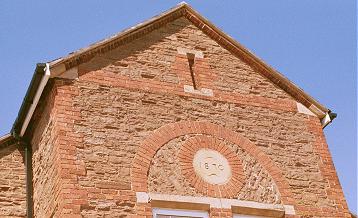
Monmouth, 2000.
© Peter Higginbotham.
In 1909, electric lighting was installed at the workhouse.
After 1930, the former workhouse operated as a Public Assistance Institution for some years.
The former workhouse buildings are now occupied by part of Monmouth's Haberdashers' Schools.
Staff
Inmates
Records
Note: many repositories impose a closure period of up to 100 years for records identifying individuals. Before travelling a long distance, always check that the records you want to consult will be available.
- Gwent Archives, Steelworks Road, Ebbw Vale NP23 6DN. Holdings include: Guardians' minute books (1839-41, 1847-49, 1857-1930); Admissions and discharges (1853-1926, with gaps); Births and deaths (1866-1914); Creed register (1881-1930); Punishment Book (1859-1930); etc.
Bibliography
- Higginbotham, Peter The Workhouse Encyclopedia (2014, The History Press)
- NEW! Workhouses of Wales and the Welsh Borders. The story of the workhouse across the whole of Wales and the border counties of Cheshire, Gloucestershire, Herefordshire and Shropshire. More...
Links
- None.
Unless otherwise indicated, this page () is copyright Peter Higginbotham. Contents may not be reproduced without permission.


